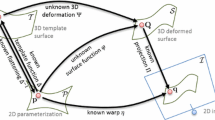Abstract
We propose a new deformable shape model Active Shape Structural Model (ASSM) for recognition and reconstruction. The main features of ASSM are: (1) It describes variations of shape not only statistically as Active shape/Appearance model but also by structural variations. (2) Statistical and structural prior knowledge is integrated resulting in a multi-resolution shape description such that the statistical variation becomes more constrained as structural information is added. Experiments on hand drawn sketches of mechanical systems using electronic ink demonstrate the ability of the deformable model to recognize objects structurally and reconstruct them statistically.
Access this chapter
Tax calculation will be finalised at checkout
Purchases are for personal use only
Preview
Unable to display preview. Download preview PDF.
Similar content being viewed by others
References
Cootes, T., Taylor, C.: Statistical Models of Appearance for Medical Image Analysis and Computer Vision. In: SPIE Proc. Medical Imaging:Image Processing, vol. 4322, pp. 236–248 (2001)
Mitchell, S., Lelieveldt, B., van der Geest, et al.: Time Continuous Segmentation of Cardiac MR Image Sequences using Active Appearance Motion Models. In: SPIE Proc. Medical Imaging: Image Processing, vol. 4322, pp. 249–256 (2001)
Chen, M.: 3-D Deformable Registration Using a Statistical Atlas with Applications in Medicine. In: Taylor, C., Colchester, A. (eds.) MICCAI 1999. LNCS, vol. 1679, pp. 621–630. Springer, Heidelberg (1999)
Malladi, R., Sethian, J., Vemuri, B.: Shape Modeling with Front Propagation: A Level Set Approach. IEEE PAMI 17(2), 158–175 (1995)
Szeliski, R., Tonnesen, D., Terzopoulos, D.: Modeling Surfaces of Arbitrary Topology with Dynamic particles. In: Proc. Computer Vision and Vision Recognition (CVPR), pp. 82–87 (1993)
McInerney, T., Terzopoulos, D.: Topology Adaptive Deformable Surfaces for Medical Image Volume Segmentation. IEEE Trans. on Medical Imaging 18(9), 100–111 (1999)
Siddiqi, K., Kimia, B.: Toward a Shock Grammar for Recognition. In: IEEE Conf. on Computer Vision and Pattern Recognition (1996)
DeCarlo, D., Metaxas, D.: Shape Evolution with Structural and Topological Changes using Blending. IEEE PAMI 20(11), 1186–1205 (1998)
Al-Zubi, S., Tönnies, K.: Extending Active Shape Models to Incorporate a-priori Knowledge about Structural Variability. In: Van Gool, L. (ed.) DAGM 2002. LNCS, vol. 2449, pp. 338–344. Springer, Heidelberg (2002)
Mokhtarian, F., Abbasi, S., Kittler, J.: Robust and Efficient Shape Indexing through Curvature Scale Space. In: Proc. British Machine Vision Conference, pp. 53–62 (1996)
Wu, K., Levine, M.: Segmenting 3D Objects into Geons. In: ICIAP, pp. 321–334 (1995)
Veltcamp, R., Tanase, M.: Content-Based Image retrieval Systems: A Survey. Technical report UU-CS-2000-34, Department of Computing Science, Utrecht University (2000)
Lin, J., Newman, M., et al.: DENIM: Finding a Tighter Fit Between Tools and Practice for Web Site Design. CHI Letters: Human Factors in Computing Systems, 510–517 (2000)
Alvarado, C., Davis, R.: Resolving ambiguities to create a natural computer-based sketching environment. In: IJCAI-2001 (2001)
Chans, Y., Lei, Z., Lopresti, D., Kung, S.: A Feature-Based Approach for Image Retrieval by Sketch. In: SPIE Proc. Multimedia Storage and Archiving Systems (1997)
Fonseca, M., Jorge, J.: Using Fuzzy Logic to Recognize Geometric Shapes Interactively. In: FUZZIEEE (2000)
Author information
Authors and Affiliations
Editor information
Editors and Affiliations
Rights and permissions
Copyright information
© 2003 Springer-Verlag Berlin Heidelberg
About this paper
Cite this paper
Al-Zubi, S., Tönnies, K. (2003). Generalizing the Active Shape Model by Integrating Structural Knowledge to Recognize Hand Drawn Sketches. In: Petkov, N., Westenberg, M.A. (eds) Computer Analysis of Images and Patterns. CAIP 2003. Lecture Notes in Computer Science, vol 2756. Springer, Berlin, Heidelberg. https://doi.org/10.1007/978-3-540-45179-2_40
Download citation
DOI: https://doi.org/10.1007/978-3-540-45179-2_40
Publisher Name: Springer, Berlin, Heidelberg
Print ISBN: 978-3-540-40730-0
Online ISBN: 978-3-540-45179-2
eBook Packages: Springer Book Archive




